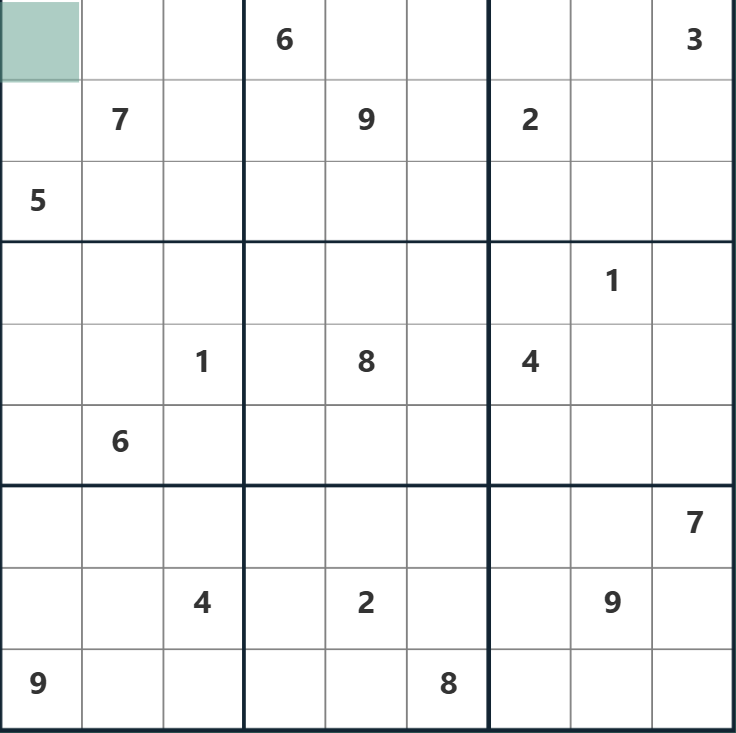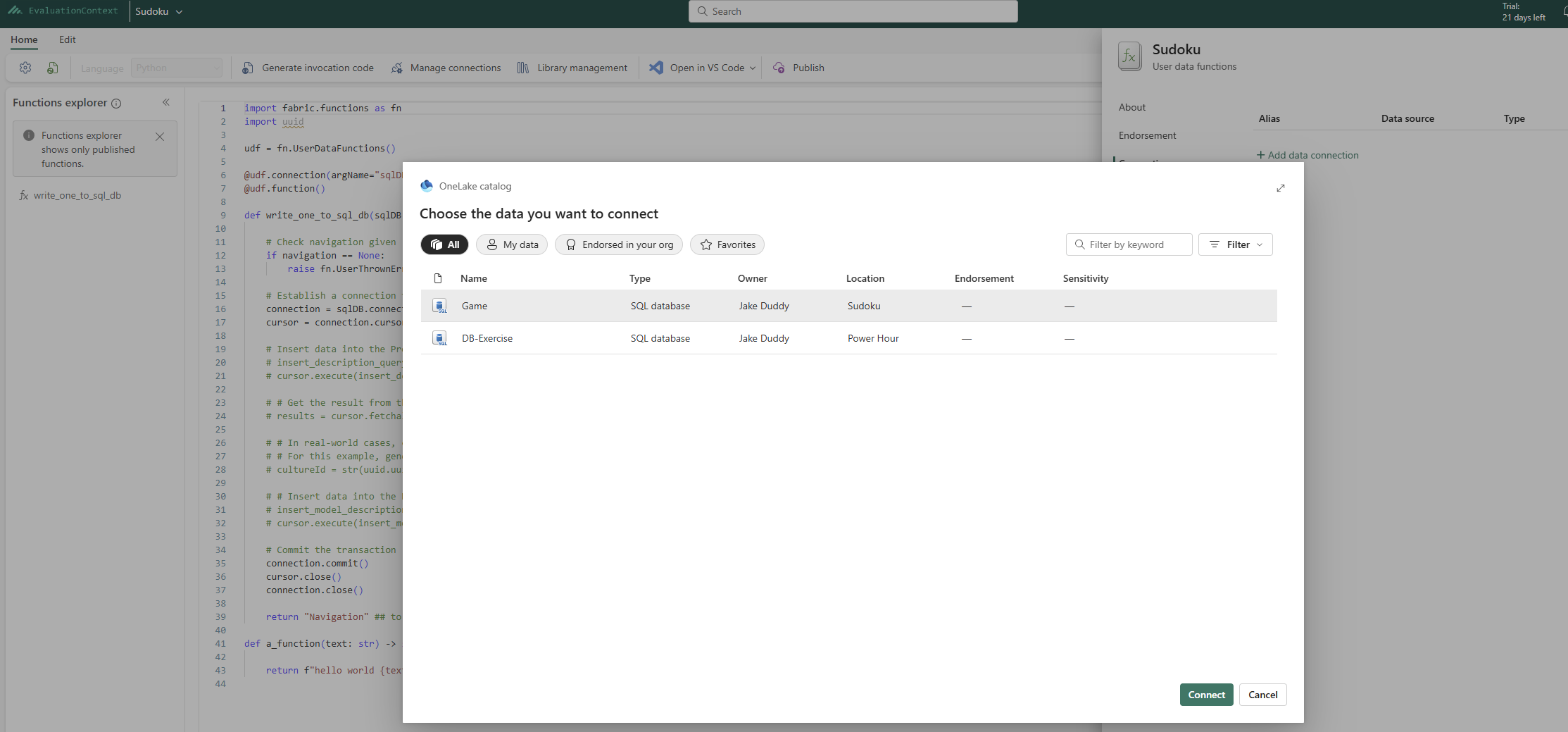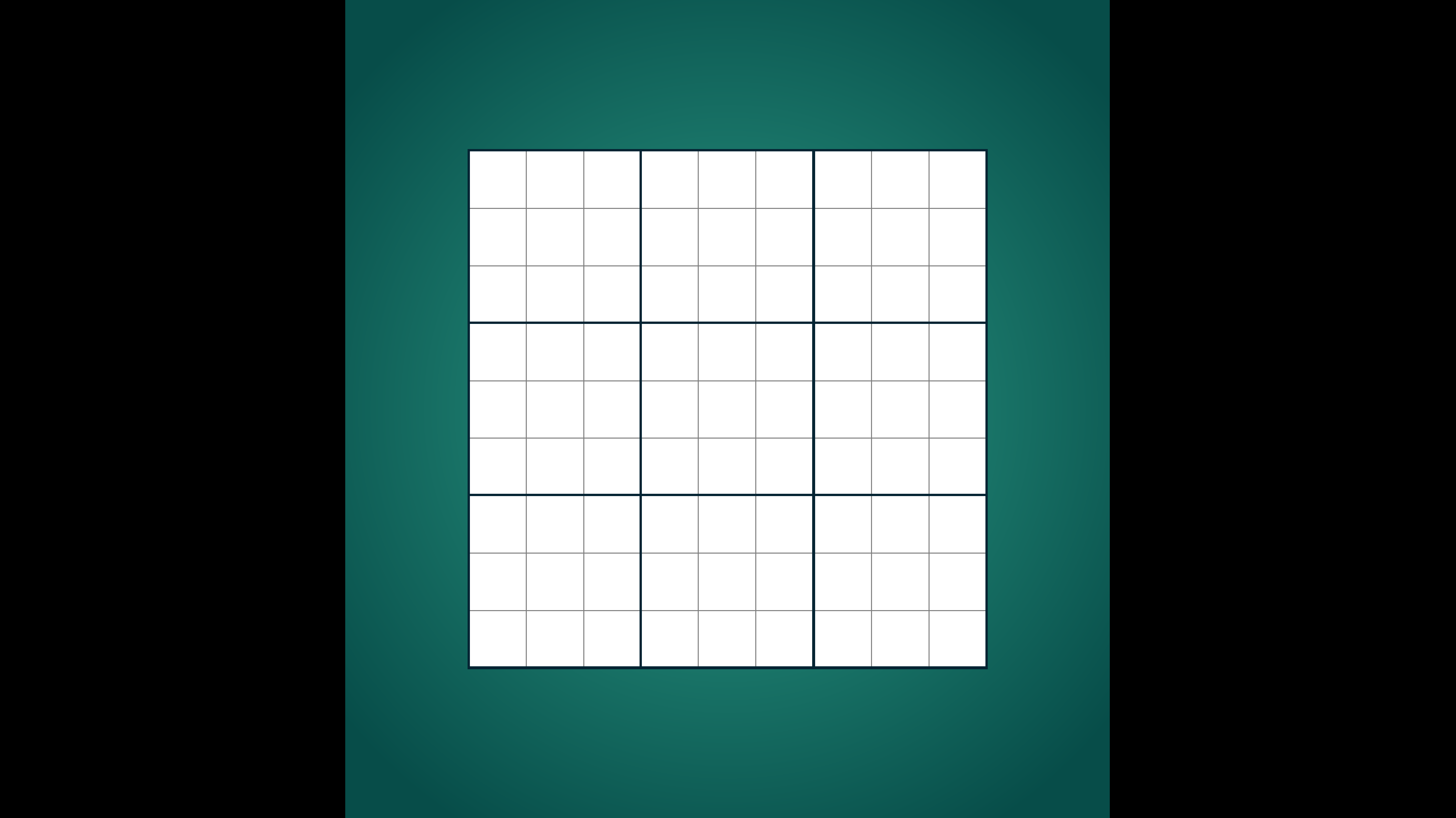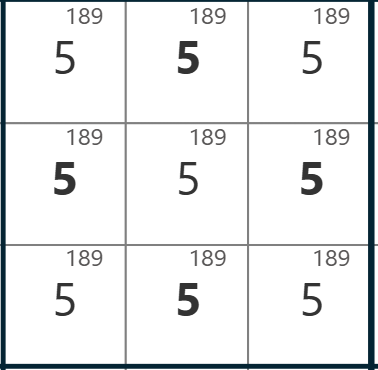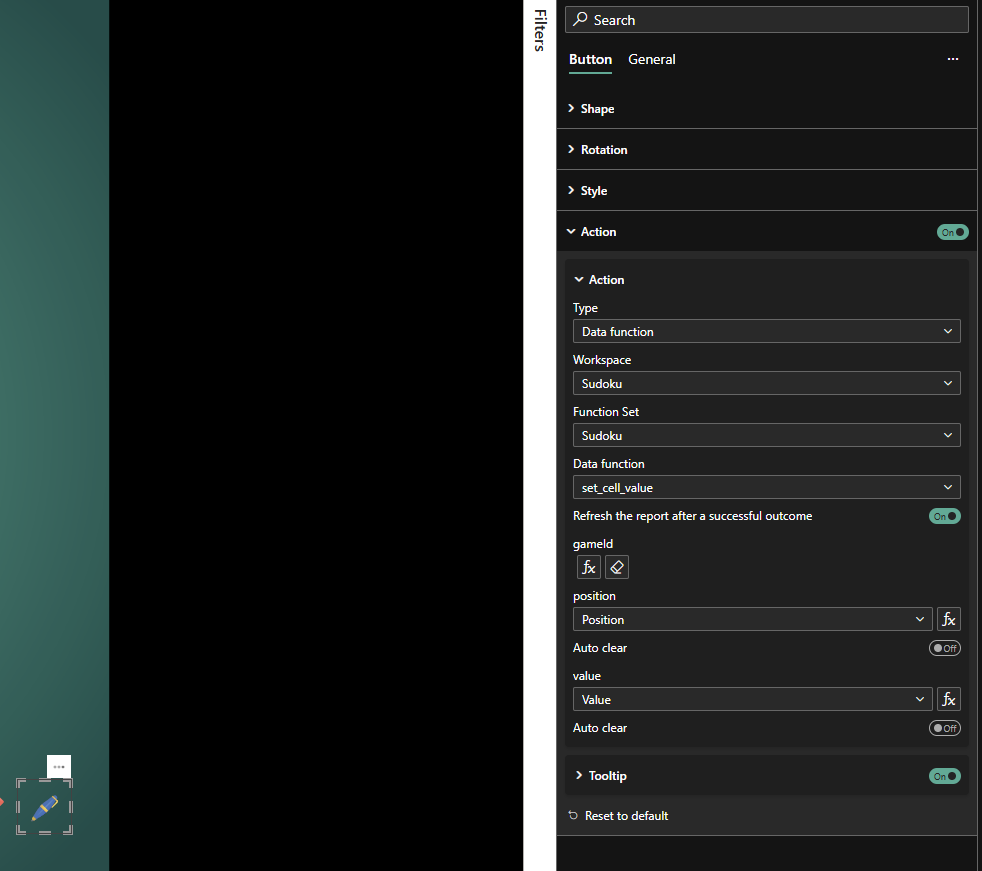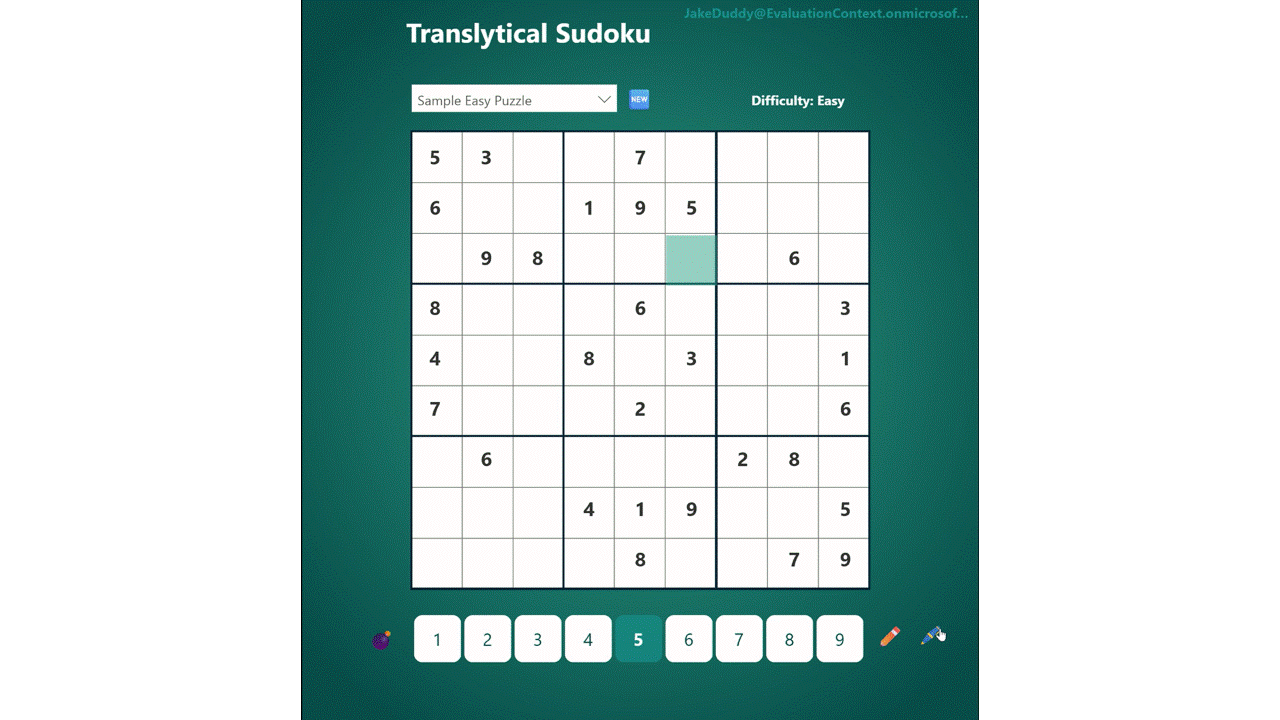Translytical Sudoku
Sudoku in Power BI using Translytical Task Flows
Microsoft's recent announcement of Translytical Task Flows for Power BI has opened up a world of practical applications. But for me, the first thought was how can I use this to do something impractical and build a game? I previously inspired by Phil Seamark impressive collection Power BI games, especially his innovative Sudoku implementation that maintained game state using slicers! With the full power of Microsoft Fabric and a backend database, we can now truly manage game state, making the game simpler to build and play, whilst also making it more feature rich.
Understanding Translytical Task Flows¶
Translytical Task Flows, while still in preview, are a game-changer for Power BI users. To enable them, you'll need to go to Options > Preview features > Translytical Task Flows in Power BI Desktop.
At their core, they allow buttons within your Power BI reports to trigger Fabric User Data Functions (UDF). UDFs are python function that can perform an action, such as initiate changes in a Fabric SQL database. Within the button definition you map a button, list, or text slicer; a data field; or measures from the report to the input parameters of the UDF.
Design Considerations¶
Sudoku is a logic puzzle played on a 9x9 grid. Your goal is to fill the grid with digits from 1 to 9, ensuring that each column, each row, and each of the nine 3x3 subgrids contains all the digits from 1 to 9.
Our approach leverages a Fabric SQL database to store the game's initial state and, crucially, the player's progress. Players will interact with the Power BI report by selecting a cell on the grid and a candidate value. Pressing a button will then activate a UDF, which in turn updates the database.
A key feature for serious Sudoku players is pencil marks. These small numbers in the corners of a cell represent all possible valid digits for that cell. Our game will support this by allowing players to toggle pencil marks using a dedicated button.
Considering that multiple users might access the report, we'll implement Row Level Security (RLS) using USERPRINCIPALNAME() to ensure each player can only access their own games.
Here's an architectural overview of how all these components fit together:
Creating The SQL Database¶
The first step is to set up our Fabric SQL database with the necessary tables to manage game data:
- PuzzleTemplates: Stores predefined Sudoku puzzles
- PuzzleInitialState: Records the starting values for each puzzle template
- Games: Tracks individual game instances initiated by players
- GameState: Holds the current values entered by players for a specific game
- PencilMarks: Manages the pencil marks added by players
CREATE TABLE PuzzleTemplates (
PuzzleId INT PRIMARY KEY IDENTITY(1,1),
PuzzleName NVARCHAR(100),
Difficulty NVARCHAR(20),
CreatedDate DATETIME2 DEFAULT GETDATE()
);
CREATE TABLE PuzzleInitialState (
PuzzleId INT,
Position INT CHECK (Position BETWEEN 1 AND 81),
InitialValue INT CHECK (InitialValue BETWEEN 1 AND 9),
PRIMARY KEY (PuzzleId, Position),
FOREIGN KEY (PuzzleId) REFERENCES PuzzleTemplates(PuzzleId)
);
CREATE TABLE Games (
GameId INT PRIMARY KEY IDENTITY(1,1),
PuzzleId INT,
GameName NVARCHAR(100),
CreatedDate DATETIME2 DEFAULT GETDATE(),
LastModifiedDate DATETIME2 DEFAULT GETDATE(),
FOREIGN KEY (PuzzleId) REFERENCES PuzzleTemplates(PuzzleId)
);
CREATE TABLE GameState (
GameId INT,
Position INT CHECK (Position BETWEEN 1 AND 81),
CurrentValue INT CHECK (CurrentValue BETWEEN 1 AND 9),
IsInitialValue BIT DEFAULT 0,
LastModifiedDate DATETIME2 DEFAULT GETDATE(),
PRIMARY KEY (GameId, Position),
FOREIGN KEY (GameId) REFERENCES Games(GameId)
);
CREATE TABLE PencilMarks (
GameId INT,
Position INT CHECK (Position BETWEEN 1 AND 81),
PencilValue INT CHECK (PencilValue BETWEEN 1 AND 9),
IsActive BIT DEFAULT 1,
CreatedDate DATETIME2 DEFAULT GETDATE(),
LastModifiedDate DATETIME2 DEFAULT GETDATE(),
PRIMARY KEY (GameId, Position, PencilValue),
FOREIGN KEY (GameId) REFERENCES Games(GameId)
);
To efficiently populate our Sudoku grid in Power BI via Direct Query, we'll create a view that combines all relevant game state information:
CREATE VIEW vw_GameState AS
SELECT
g.GameId,
g.GameName,
g.PuzzleId,
coord.Position,
gs.CurrentValue,
gs.IsInitialValue,
STRING_AGG(CAST(pm.PencilValue AS VARCHAR), '') AS PencilMarks
FROM Games g
CROSS JOIN (
-- Generate all possible positions (1-81)
SELECT ROW_NUMBER() OVER (ORDER BY (SELECT NULL)) AS Position
FROM (VALUES (1),(2),(3),(4),(5),(6),(7),(8),(9)) X(n)
CROSS JOIN (VALUES (1),(2),(3),(4),(5),(6),(7),(8),(9)) Y(n)
) coord
LEFT JOIN GameState gs ON g.GameId = gs.GameId
AND coord.Position = gs.Position
LEFT JOIN PencilMarks pm ON g.GameId = pm.GameId
AND coord.Position = pm.Position
AND pm.IsActive = 1
GROUP BY g.GameId, g.GameName, g.PuzzleId,
coord.Position, gs.CurrentValue, gs.IsInitialValue;
We'll use stored procedures to encapsulate the core game actions, making them callable from our UDFs:
sp_InitializeGame: Creates a new instance of a puzzle for a playersp_SetCellValue: Adds or removes a selected digit from a selected cellsp_TogglePencilMarkAdds or removes a pencil mark for a selected cellsp_ClearUserEntriesResets all user-entered digits and pencil marks for the current game
CREATE PROCEDURE sp_InitializeGame
@GameName NVARCHAR(100),
@PuzzleId INT
AS
BEGIN
DECLARE @GameId INT;
-- Check if game with same name and puzzle already exists
IF EXISTS (SELECT 1 FROM Games WHERE GameName = @GameName AND PuzzleId = @PuzzleId)
BEGIN
RAISERROR('A game with this name already exists for this puzzle.', 16, 1);
RETURN;
END;
-- Create new game
INSERT INTO Games (GameName, PuzzleId)
VALUES (@GameName, @PuzzleId);
SET @GameId = SCOPE_IDENTITY();
-- Copy initial state from puzzle template
INSERT INTO GameState (GameId, Position, CurrentValue, IsInitialValue)
SELECT @GameId, pis.Position, pis.InitialValue, 1
FROM PuzzleInitialState pis
WHERE pis.PuzzleId = @PuzzleId;
SELECT @GameId AS GameId;
END;
GO
CREATE PROCEDURE sp_SetCellValue
@GameId INT,
@Position INT,
@Value INT
AS
BEGIN
-- Check if cell is an initial value (cannot be changed)
IF EXISTS (SELECT 1 FROM GameState
WHERE GameId = @GameId AND Position = @Position AND IsInitialValue = 1)
BEGIN
RAISERROR('Cannot modify initial puzzle values.', 16, 1);
RETURN;
END;
-- Check if trying to set the same value that's already there (toggle off)
IF EXISTS (SELECT 1 FROM GameState
WHERE GameId = @GameId AND Position = @Position
AND CurrentValue = @Value AND IsInitialValue = 0)
BEGIN
-- Remove the value (toggle off)
DELETE FROM GameState
WHERE GameId = @GameId AND Position = @Position;
-- Clear pencil marks for this cell
DELETE FROM PencilMarks
WHERE GameId = @GameId AND Position = @Position;
RETURN;
END;
-- Insert or update the cell value
MERGE GameState AS target
USING (VALUES (@GameId, @Position, @Value)) AS source (GameId, Position, CurrentValue)
ON target.GameId = source.GameId
AND target.Position = source.Position
WHEN MATCHED THEN
UPDATE SET CurrentValue = source.CurrentValue, LastModifiedDate = GETDATE()
WHEN NOT MATCHED THEN
INSERT (GameId, Position, CurrentValue, IsInitialValue)
VALUES (source.GameId, source.Position, source.CurrentValue, 0);
-- Clear pencil marks for this cell
DELETE FROM PencilMarks
WHERE GameId = @GameId AND Position = @Position;
END;
GO
CREATE PROCEDURE sp_TogglePencilMark
@GameId INT,
@Position INT,
@PencilValue INT
AS
BEGIN
-- Only allow pencil marks if cell is empty
IF EXISTS (SELECT 1 FROM GameState
WHERE GameId = @GameId AND Position = @Position AND CurrentValue IS NOT NULL)
BEGIN
RAISERROR('Cannot add pencil marks to filled cells.', 16, 1);
RETURN;
END;
-- Toggle the pencil mark
IF EXISTS (SELECT 1 FROM PencilMarks
WHERE GameId = @GameId AND Position = @Position
AND PencilValue = @PencilValue AND IsActive = 1)
BEGIN
-- Remove the pencil mark
UPDATE PencilMarks
SET IsActive = 0, LastModifiedDate = GETDATE()
WHERE GameId = @GameId AND Position = @Position
AND PencilValue = @PencilValue;
END
ELSE
BEGIN
-- Add or reactivate the pencil mark
MERGE PencilMarks AS target
USING (VALUES (@GameId, @Position, @PencilValue)) AS source (GameId, Position, PencilValue)
ON target.GameId = source.GameId
AND target.Position = source.Position
AND target.PencilValue = source.PencilValue
WHEN MATCHED THEN
UPDATE SET IsActive = 1, LastModifiedDate = GETDATE()
WHEN NOT MATCHED THEN
INSERT (GameId, Position, PencilValue, IsActive)
VALUES (source.GameId, source.Position, source.PencilValue, 1);
END;
END;
GO
CREATE PROCEDURE sp_ClearUserEntries
@GameId INT
AS
BEGIN
-- Delete all user-entered values (keep only initial values)
DELETE FROM GameState
WHERE GameId = @GameId AND IsInitialValue = 0;
-- Clear all pencil marks
DELETE FROM PencilMarks
WHERE GameId = @GameId;
-- Update game's last modified date
UPDATE Games
SET LastModifiedDate = GETDATE()
WHERE GameId = @GameId;
END;
GO
Finally, let's add some sample Sudoku puzzles to our PuzzleTemplates and PuzzleInitialState tables:
INSERT INTO PuzzleTemplates (PuzzleName, Difficulty) VALUES
('Sample Easy Puzzle', 'Easy'),
('Sample Medium Puzzle', 'Medium'),
('Sample Hard Puzzle', 'Hard'),
('Sample Expert Puzzle', 'Expert');
-- EASY PUZZLE (PuzzleId = 1) - converted to positions
-- Position mapping: Position = (Row-1) * 9 + Column
-- Row 1: positions 1-9, Row 2: positions 10-18, etc.
INSERT INTO PuzzleInitialState (PuzzleId, Position, InitialValue) VALUES
-- Row 1: 5 3 . | . 7 . | . . .
(1, 1, 5), (1, 2, 3), (1, 5, 7),
-- Row 2: 6 . . | 1 9 5 | . . .
(1, 10, 6), (1, 13, 1), (1, 14, 9), (1, 15, 5),
-- Row 3: . 9 8 | . . . | . 6 .
(1, 20, 9), (1, 21, 8), (1, 26, 6),
-- Row 4: 8 . . | . 6 . | . . 3
(1, 28, 8), (1, 32, 6), (1, 36, 3),
-- Row 5: 4 . . | 8 . 3 | . . 1
(1, 37, 4), (1, 40, 8), (1, 42, 3), (1, 45, 1),
-- Row 6: 7 . . | . 2 . | . . 6
(1, 46, 7), (1, 50, 2), (1, 54, 6),
-- Row 7: . 6 . | . . . | 2 8 .
(1, 56, 6), (1, 61, 2), (1, 62, 8),
-- Row 8: . . . | 4 1 9 | . . 5
(1, 67, 4), (1, 68, 1), (1, 69, 9), (1, 72, 5),
-- Row 9: . . . | . 8 . | . 7 9
(1, 77, 8), (1, 80, 7), (1, 81, 9);
-- MEDIUM PUZZLE (PuzzleId = 2) - converted to positions
INSERT INTO PuzzleInitialState (PuzzleId, Position, InitialValue) VALUES
-- Row 1: . . . | 6 . . | . . 3
(2, 4, 6), (2, 9, 3),
-- Row 2: . 7 . | . 9 . | 2 . .
(2, 11, 7), (2, 14, 9), (2, 16, 2),
-- Row 3: 5 . . | . . . | . . .
(2, 19, 5),
-- Row 4: . . . | . . . | . 1 .
(2, 35, 1),
-- Row 5: . . 1 | . 8 . | 4 . .
(2, 39, 1), (2, 41, 8), (2, 43, 4),
-- Row 6: . 6 . | . . . | . . .
(2, 47, 6),
-- Row 7: . . . | . . . | . . 7
(2, 63, 7),
-- Row 8: . . 4 | . 2 . | . 9 .
(2, 66, 4), (2, 68, 2), (2, 71, 9),
-- Row 9: 9 . . | . . 8 | . . .
(2, 73, 9), (2, 78, 8);
-- HARD PUZZLE (PuzzleId = 3) - converted to positions
INSERT INTO PuzzleInitialState (PuzzleId, Position, InitialValue) VALUES
-- Row 1: . . . | . . . | . 1 .
(3, 8, 1),
-- Row 2: 4 . . | . . . | . . .
(3, 10, 4),
-- Row 3: . . . | . . . | 6 . 2
(3, 25, 6), (3, 27, 2),
-- Row 4: . . . | . . . | . 7 .
(3, 35, 7),
-- Row 5: . 8 . | . . . | . 4 .
(3, 38, 8), (3, 44, 4),
-- Row 6: . 3 . | . . . | . . .
(3, 47, 3),
-- Row 7: 7 . 9 | . . . | . . .
(3, 55, 7), (3, 57, 9),
-- Row 8: . . . | . . . | . . 5
(3, 72, 5),
-- Row 9: . 2 . | . . . | . . .
(3, 74, 2);
-- EXPERT PUZZLE (PuzzleId = 4) - converted to positions
INSERT INTO PuzzleInitialState (PuzzleId, Position, InitialValue) VALUES
-- Row 1: . . . | . . . | . . 9
(4, 9, 9),
-- Row 2: . . . | . . 3 | . 8 .
(4, 15, 3), (4, 17, 8),
-- Row 3: . . 1 | . 2 . | . . .
(4, 21, 1), (4, 23, 2),
-- Row 4: . . . | . . . | . . 2
(4, 36, 2),
-- Row 5: . . . | 2 . . | . . .
(4, 40, 2),
-- Row 6: 6 . . | . . . | . . .
(4, 46, 6),
-- Row 7: . . . | . 5 . | 7 . .
(4, 59, 5), (4, 61, 7),
-- Row 8: . 4 . | 9 . . | . . .
(4, 65, 4), (4, 67, 9),
-- Row 9: 1 . . | . . . | . . .
(4, 73, 1);
Creating The User Data Functions¶
With our database set up, we now need to create the UDFs that will act as the bridge between the Power BI report and our SQL stored procedures.
First, you'll need to set up a connection to your Fabric SQL server within your UDF environment:
Next, we define our Python UDFs, each calling a specific stored procedure:
initialize_game: Callssp_InitializeGameset_cell_value: Callssp_SetCellValuetoggle_pencil_mark: Callssp_TogglePencilMarkclear_user_entries: Callssp_ClearUserEntries
import fabric.functions as fn
import json
from datetime import datetime
udf = fn.UserDataFunctions()
@udf.connection(argName="sqlDB", alias="Game")
@udf.function()
def initialize_game(sqlDB: fn.FabricSqlConnection, gameName: str, puzzleId: int) -> str:
"""
Initialize a new Sudoku game from a puzzle template
Prevents duplicate game names for the same puzzle
Args:
gameName: Name for the new game
puzzleId: ID of the puzzle template to use
Returns:
Str with game initialization result
"""
try:
conn = sqlDB.connect()
cursor = conn.cursor()
# Check if game with same name and puzzle already exists
cursor.execute("""
SELECT COUNT(*) FROM Games
WHERE GameName = ? AND PuzzleId = ?
""", (gameName, puzzleId))
if cursor.fetchone()[0] > 0:
return json.dumps(
{
"status": "ERROR",
"message": "A game with this name already exists for this puzzle. Please choose a different name.",
"game_id": None
}
)
# Execute the stored procedure
cursor.execute("EXEC sp_InitializeGame ?, ?", (gameName, puzzleId))
# Commit the transaction
conn.commit()
# Get the new game ID
cursor.execute("""
SELECT TOP 1 GameId, GameName, CreatedDate
FROM Games
WHERE GameName = ? AND PuzzleId = ?
ORDER BY CreatedDate DESC
""", (gameName, puzzleId))
game_details = cursor.fetchone()
if game_details:
return json.dumps(
{
"status": "SUCCESS",
"message": "Game initialized successfully",
"game_id": game_details[0],
"gameName": game_details[1],
"puzzleId": puzzleId,
"created_date": game_details[2].isoformat(),
}
)
else:
return json.dumps(
{
"status": "ERROR",
"message": "Failed to initialize game - game not found after creation",
"game_id": None
}
)
except Exception as e:
return json.dumps(
{
"status": "ERROR",
"message": f"Database error: {str(e)}",
"game_id": None
}
)
finally:
cursor.close()
conn.close()
@udf.connection(argName="sqlDB", alias="Game")
@udf.function()
def set_cell_value(sqlDB: fn.FabricSqlConnection, gameId: int, position: int, value: int) -> str:
"""
Set a value in a Sudoku cell - now supports toggling off user-entered values
Args:
gameId: The game ID
position: Cell position (1-81)
value: Value to set (1-9)
Returns:
Str with operation result
"""
try:
# Validate inputs
if not (1 <= position <= 81 and 1 <= value <= 9):
return json.dumps(
{
"status": "ERROR",
"message": "Invalid position or value. Position must be 1-81, value must be 1-9.",
"action_time": datetime.now().isoformat()
}
)
conn = sqlDB.connect()
cursor = conn.cursor()
# Check current state of the cell
cursor.execute("""
SELECT CurrentValue, IsInitialValue FROM GameState
WHERE GameId = ? AND Position = ?
""", (gameId, position))
result = cursor.fetchone()
# Determine the action that will be taken
action_type = "set"
if result:
if result[1] == 1: # IsInitialValue = 1
return json.dumps(
{
"status": "ERROR",
"message": "Cannot modify initial puzzle values",
"action_time": datetime.now().isoformat()
}
)
elif result[0] == value: # Same value already there
action_type = "toggled_off"
# Execute the stored procedure
cursor.execute("EXEC sp_SetCellValue ?, ?, ?",
(gameId, position, value))
conn.commit()
# Check final state to confirm action
cursor.execute("""
SELECT CurrentValue FROM GameState
WHERE GameId = ? AND Position = ?
""", (gameId, position))
final_result = cursor.fetchone()
final_value = final_result[0] if final_result else None
if action_type == "toggled_off":
message = f"Value {value} toggled off at position {position}"
else:
message = f"Value {value} set at position {position}"
return json.dumps(
{
"status": "SUCCESS",
"message": message,
"game_id": gameId,
"position": position,
"requested_value": value,
"final_value": final_value,
"action_type": action_type,
"action_time": datetime.now().isoformat()
}
)
except Exception as e:
return json.dumps(
{
"status": "ERROR",
"message": f"Database error: {str(e)}",
"action_time": datetime.now().isoformat()
}
)
finally:
cursor.close()
conn.close()
@udf.connection(argName="sqlDB", alias="Game")
@udf.function()
def toggle_pencil_mark(sqlDB: fn.FabricSqlConnection, gameId: int, position: int, pencilValue: int) -> str:
"""
Toggle a pencil mark in a Sudoku cell
Args:
gameId: The game ID
position: Cell position (1-81)
pencilValue: Pencil mark value (1-9)
Returns:
Str with operation result
"""
try:
# Validate inputs
if not (1 <= position <= 81 and 1 <= pencilValue <= 9):
return json.dumps(
{
"status": "ERROR",
"message": "Invalid position or pencil value. Position must be 1-81, value must be 1-9.",
"action_time": datetime.now().isoformat()
}
)
conn = sqlDB.connect()
cursor = conn.cursor()
# Check if cell has a value (cannot add pencil marks)
cursor.execute("""
SELECT CurrentValue FROM GameState
WHERE GameId = ? AND Position = ?
""", (gameId, position))
result = cursor.fetchone()
if result and result[0] is not None:
return json.dumps(
{
"status": "ERROR",
"message": "Cannot add pencil marks to filled cells",
"action_time": datetime.now().isoformat()
}
)
# Execute the stored procedure
cursor.execute("EXEC sp_TogglePencilMark ?, ?, ?",
(gameId, position, pencilValue))
conn.commit()
# Check if pencil mark was added or removed
cursor.execute("""
SELECT IsActive FROM PencilMarks
WHERE GameId = ? AND Position = ? AND PencilValue = ?
""", (gameId, position, pencilValue))
pencil_result = cursor.fetchone()
is_active = pencil_result[0] if pencil_result else False
action_type = "added" if is_active else "removed"
return json.dumps(
{
"status": "SUCCESS",
"message": f"Pencil mark {pencilValue} {action_type} at position {position}",
"game_id": gameId,
"position": position,
"pencil_value": pencilValue,
"is_active": is_active,
"action_type": action_type,
"action_time": datetime.now().isoformat()
}
)
except Exception as e:
return json.dumps(
{
"status": "ERROR",
"message": f"Database error: {str(e)}",
"action_time": datetime.now().isoformat()
}
)
finally:
cursor.close()
conn.close()
@udf.connection(argName="sqlDB", alias="Game")
@udf.function()
def clear_user_entries(sqlDB: fn.FabricSqlConnection, gameId: int) -> str:
"""
Clear all user-entered values from a Sudoku game, keeping only initial puzzle values
Args:
gameId: The game ID
Returns:
Str with operation result
"""
try:
conn = sqlDB.connect()
cursor = conn.cursor()
# Verify game exists
cursor.execute("SELECT GameName FROM Games WHERE GameId = ?", (gameId,))
game_result = cursor.fetchone()
if not game_result:
return json.dumps(
{
"status": "ERROR",
"message": "Game not found",
"action_time": datetime.now().isoformat()
}
)
# Count user entries before clearing
cursor.execute("""
SELECT COUNT(*) FROM GameState
WHERE GameId = ? AND IsInitialValue = 0
""", (gameId,))
user_entries_count = cursor.fetchone()[0]
# Count pencil marks before clearing
cursor.execute("""
SELECT COUNT(*) FROM PencilMarks
WHERE GameId = ? AND IsActive = 1
""", (gameId,))
pencil_marks_count = cursor.fetchone()[0]
# Execute the stored procedure
cursor.execute("EXEC sp_ClearUserEntries ?", (gameId,))
conn.commit()
return json.dumps(
{
"status": "SUCCESS",
"message": f"Cleared {user_entries_count} user entries and {pencil_marks_count} pencil marks",
"game_id": gameId,
"game_name": game_result[0],
"cleared_entries": user_entries_count,
"cleared_pencil_marks": pencil_marks_count,
"action_time": datetime.now().isoformat()
}
)
except Exception as e:
return json.dumps(
{
"status": "ERROR",
"message": f"Database error: {str(e)}",
"action_time": datetime.now().isoformat()
}
)
finally:
cursor.close()
conn.close()
Creating The Power BI Report¶
Now, let's bring it all together in the Power BI report, following our architectural design.
Report Background¶
We'll start by setting a background image that includes the Sudoku grid:
Puzzle Selector¶
To allow players to choose a puzzle, we'll use the PuzzleTemplates table and add the PuzzleName field to a slicer so that the player can select a template that they want to play.
We'll also need a DAX measure to pass the PuzzleId to the UDFs:
Number Selector¶
Players need to select a digit (1-9) to enter into the grid. A simple DAX table and a button slicer will do the trick:
Sudoku Grid¶
Instead of a standard Matrix visual, which has limitations in terms of visual customization, I opted for another button slicer, which has extensive formatting options and control. We'll create a DAX table with 81 positions, one for each cell:
Grid Position =
var tbl = GENERATESERIES( 1, 81, 1 )
return
SELECTCOLUMNS(
tbl,
"Position", [Value]
)
These button slicers will then be aligned with the Sudoku grid image in our background.
To display both the main cell values and the smaller pencil marks, we'll use an SVG measure. This allows for dynamic and highly customizable cell content.
Measure: Data Category
For SVG to render as a image instead of text the Data Category of the measure needs to be set to "Image URL"
Cell =
var width = 40
var height = 40
var mainFontSize = 16
var pencilFontSize = 8
var isInitial =
IF(
CALCULATE(
MAXX( GameState, INT( GameState[IsInitialValue] ) )
,TREATAS( VALUES( 'Grid Position'[Position] ), GameState[Position] )
),
" font-weight='bold'"
)
var val =
CALCULATE(
MAX( GameState[CurrentValue] )
,TREATAS( VALUES( 'Grid Position'[Position] ), GameState[Position] )
)
var pencil =
CALCULATE(
MAX( GameState[PencilMarks] )
,TREATAS( VALUES( 'Grid Position'[Position] ), GameState[Position] )
)
return
"data:image/svg+xml;charset=utf8,
<svg xmlns='http://www.w3.org/2000/svg' width='"& width & "' height='"& height & "'>
<text x='"& width / 2 & "' y='"& height /2 & "' font-size='" & mainFontSize & "' font-family='Segoe UI' dominant-baseline='middle' text-anchor='middle' fill='#333'" & isInitial & ">" & val & "</text>
<text x='"& width / 2 & "' y='5' font-size='" & pencilFontSize & "' font-family='Segoe UI' dominant-baseline='middle' text-anchor='right' fill='#575555'>" & pencil & "</text>
</svg>"
Buttons¶
Finally, we'll add four buttons, each linked to one of our UDFs. We'll also need a couple of additional DAX measures to pass the current user's name and selected game ID:
The crucial step is to map the appropriate slicer fields and measures to the input parameters of each UDF:
Row Level Security¶
To ensure players only interact with their own games, we'll apply RLS on the GameState table. This rule filters the data based on the logged-in user's principal name:
RLS
For the role to apply to a player, after the report has been publish to service you need to go to the workspace and select ... > security for the semantic model, and assign the player's to the role.
Keep in mind that RLS doesn't apply to workspace Admins. While I won't be subject to it, other players will experience an isolated experience from other players.
Playing the Game!¶
With everything configured and published to the Power BI service we can play the game.
Conclusion¶
This project serves as a compelling proof-of-concept, demonstrating the power and flexibility of Translytical Task Flows in Power BI and Microsoft Fabric.Hopefully this lives up to being a spiritual successor to Phil's initial work. While I'm pleased with the current state, there's always room for improvement. Future enhancements could include:
- Highlighting cells with digits that match the currently selected cell
- Highlighting the row and column of the selected cell for better guidance
- Implementing a solver or hint feature
- Providing an indicator when a player enters an incorrect value
- A celebratory animation or message upon game completion
- Allowing players to enter pencil marks into multiple cells simultaneously
